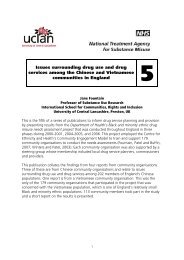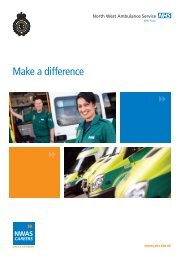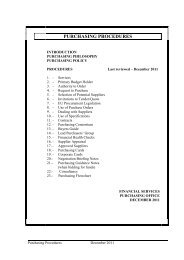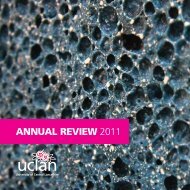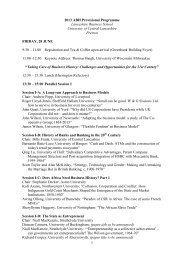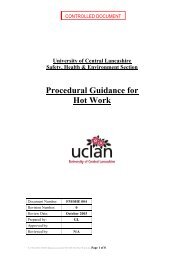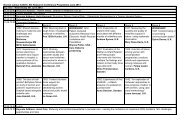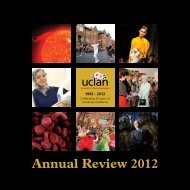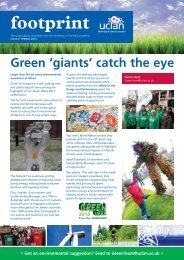WHO HEALTH IN PRISONS PROJECT(WHO HIPP) BEST ...
WHO HEALTH IN PRISONS PROJECT(WHO HIPP) BEST ...
WHO HEALTH IN PRISONS PROJECT(WHO HIPP) BEST ...
You also want an ePaper? Increase the reach of your titles
YUMPU automatically turns print PDFs into web optimized ePapers that Google loves.
WORLD <strong>HEALTH</strong> ORGANIZATION<br />
REGIONAL OFFICE FOR EUROPE<br />
WELTGESUNDHEITSORGANISATION<br />
REGIONALBÜRO FÜR EUROPA<br />
<strong>WHO</strong> <strong>HEALTH</strong> <strong>IN</strong> <strong>PRISONS</strong> <strong>PROJECT</strong>(<strong>WHO</strong> <strong>HIPP</strong>)<br />
<strong>BEST</strong> PRACTICE AWARDS SCHEME 2009<br />
APPLICATION FORM<br />
ORGANISATION MONDIALE DE LA SANTÉ<br />
BUREAU RÉGIONAL DE L'EUROPE<br />
Before filling in the form please visit the web site of the Collaborating Centre of the<br />
Health in Prisons Project (which is hosted by the University of Central Lancashire) at<br />
the following web address, where you will find useful background information on the<br />
award: http://www.uclan.ac.uk/health/schools/sphcs/wcc.php<br />
When completed please return the form electronically to your <strong>WHO</strong> Health in Prisons<br />
Project National Counterpart for consideration. The decision to forward applications<br />
to the International Judging Panel rests with your National Counterpart.<br />
Please indicate the category (you may choose only one) for your application, by<br />
typing an X in the box against the correct category<br />
X<br />
Category 1: an example of best practice regarding health care services<br />
provided to prisoners. This category includes any aspect of the clinical care<br />
provided to prisoners by doctors, nurses or other healthcare professionals.<br />
Category 2: an example of best practice regarding any of the following,<br />
or a combination of the following: prevention, health education or health<br />
promotion services provided to prisoners. For example, members of staff<br />
(not necessarily medically trained staff) working within the prison might<br />
provide the service, or it may involve peer education i.e. using specially<br />
trained prisoners.<br />
Category 3: an example of best practice, which demonstrates effective<br />
co-operation between a prison and the outside community, in the area of<br />
health improvement. This category includes any aspect of improving the<br />
health and well being of prisoners.<br />
Contact details of the person in the prison managing the application:<br />
Name: Todts Sven<br />
Job Title: Médecin Directeur<br />
Address: Place de Louvain 4, 1000 Brussels<br />
Email: sven.todts@just.fgov.be<br />
Tel No: 02/210.56.56<br />
Fax No: 02/210.55.62<br />
1
BACKGROUND <strong>IN</strong>FORMATION<br />
Title of your piece of work: STD prevention kit developed<br />
Name of country: Belgium<br />
Name of prison: Andenne<br />
Brief description of the prison and prisoners (not more than 200 words):<br />
Andenne is a detention facility which houses 400 male detainees. The prison<br />
opened in 1997 and has an infrastructure adapted to general jailing guidelines.<br />
Andenne prison is a penal institute and houses almost exclusively long term<br />
convicts.<br />
The prison aims at providing the prisoner with a choice of activities. In 2008, among<br />
these activities could be found: a music festival, an event promting reading by inviting<br />
writers into the prison for discussions and an anti-racism week.<br />
There is a staff of 360 people. Most strikingly, the prison runs a childrens' day care<br />
facility<br />
PURPOSE OF THE WORK<br />
1. What is the aim or general objective of your initiative or piece of work (in just<br />
one sentence please)?<br />
The general aim is to limit contamination risks of sexually transmissible infections by<br />
providing an effective tool adapted to the target group, in this case the detainees.<br />
2. What are the main characteristics of the target group(s)?<br />
Is it targeted at all prisoners, or a particular group or groups? e.g a<br />
particular age group.<br />
Are others being targeted e.g. such as staff involvement or involvement<br />
of families.<br />
What is the coverage of the work e.g. how many persons are being<br />
reached?<br />
All detainees i must have the possibility to access suitable means of protection<br />
against STD, to allow.safe sexual relations either with other detainess or when using<br />
the unsupervised visits by spouses or friends.<br />
One can imagine that such tools will create a greater sense of awareness toward<br />
sexually transmitted deseases (amongst prisoners and their surroundings),<br />
3. Why this initiative is important?<br />
What is the health need you are addressing?<br />
Has there been any form of needs assessment undertaken?<br />
Were you drawing upon any evidence or research to inform the piece of<br />
work? If yes please briefly refer to it here.<br />
2
During detention, the risk of contracting a sexually transmissible infection has a much<br />
higher chance of occurring. Due to promiscuity but also because of certain actions<br />
involving higher infection risks such as: drug-addiction, tattooing, piercing, or non<br />
protected sexual relations.<br />
Certain infections are much more frequent Belgian inside prison walls (e.g. 5 times<br />
more HIV and 7 times more hepatitis C<br />
4. What did you set out to achieve, and how successful were you? Please list<br />
your specific objectives in order of importance, and any indicators used to help<br />
you measure progress. (NOTE any evaluation should refer back to these<br />
objectives and indicators, indicating progress towards meeting them.)<br />
ACCESSIBILITY: We want a prevention kit (condom, lubricant, booklet) to be<br />
accessible to a maximum number of detainees, but it is also important that they the<br />
understand the message well. We therefore produced the booklet in the three<br />
national languages (Dutch, French and German) as well as in English.<br />
VISIBILITY: The preventive kit must be manufactured in a way so that colours are<br />
sharp and distinguishable from any other similar or non similar product, therefore<br />
easily locatable and thus attire the eye.<br />
EFFECTIVENESS: The delivery of a high-quality protection kit for all detainees must<br />
also be a priority.<br />
DIFUSION: It is also essential that the medical departements promote the distribution<br />
of this kit, because by doing so they will encourage the use of it.<br />
<strong>WHO</strong> WAS <strong>IN</strong>VOLVED / WHAT WAS THE TIME FRAME?<br />
5. Please describe:<br />
Those involved in delivery of the initiative? Give names, job titles and the<br />
employer of key people involved.<br />
Any prisoner involvement in the planning or delivery of the work.<br />
The time frame: When did the work commence? What did you do and<br />
when? Is there a finish date known yet?<br />
The project was developed by the team of SES Hesbaye. (Project leader: ) SES<br />
Hesbaye (president: Mme Quinet-Le Docte) is an independent organisation, funded<br />
by the French Community Government; They offer health prevention to citizens of the<br />
French Community in Belgium. Recently they focus exlusively on people in prison.<br />
The person responsible for prevention in the Prison Health Care Service (Melanie<br />
Demoitié) provided expertise and facilitated contacts with prison direction and<br />
inmates.<br />
Inmates from Andenne prison participated in the design of the kit.<br />
The prison warden (Mr.Delchavalerie ) instructed his staff to cooperate and facilitate<br />
the initiative<br />
The national prison health care service paid for the production of the kits.<br />
In the final phase, the health care services of the different prisons distributed the<br />
kits.among the prisoners<br />
3
EVALUATION<br />
6. Was there an evaluation? If yes please detail findings (not more than 300<br />
words).<br />
You may want to consider:<br />
Formative or process evaluation, concerning the quality and<br />
acceptability of your programme’s implementation with the target<br />
group.<br />
Summative evaluation: what were the outcomes and impacts in relation<br />
to your Specific Objectives and indicators as listed above.<br />
There was no formal evaluation made of the preventive kit. However, the feed-back<br />
we received was quite positive. One of the conclusions was that its diffusion had to<br />
remain the same as for the other preservatives before the creation of a small kit. On<br />
a lesser note at some prisons, the kit was diverted of its proper use.<br />
Generally the target group seemed to appreciate the quality of the small kit and the<br />
information contained inside. However, the prison health care services did not yet<br />
notice an increased demand by the detainees.<br />
ABSTRACT<br />
7. Now tell us in your own words about your piece of work or initiative and why it<br />
is important (not more than 500 words):<br />
The preventive kit is a small square kit (6 by 6 centimetres) made out of plasticized<br />
paperboard. When it is opened, one finds inside a traditional condom as well as<br />
lubricant. On the inner space there is the explanation booklet as well as other general<br />
information. The kit also contains an illustration for usage of the kit. Furthermore all<br />
explanations are given in 4 languages (French, Dutch, German and English)<br />
recongnisable by 4 different colours.<br />
The addition of a lubricant is an innovation for our prisons.<br />
LEARN<strong>IN</strong>G PO<strong>IN</strong>TS<br />
8. Finally, what are the most important specific learning points from your piece of<br />
work that you would like to share with others working with prisoners? (not more<br />
than 500 words)<br />
Including the target group in the designing process not only created a more attractive<br />
and appealing product but also more accessible.<br />
The choise of colours, graphic design and other esthetical aspects were therefore<br />
important.<br />
It was also important to include members of the personnel to spread of the kit since<br />
they are the closest contact point for most detainees. It was also necessary that they<br />
understood the importance of the project so they could collaborate on the diffusion of<br />
the product at the fullest.<br />
4
Note: please attach supporting photographs electronically to this application if you<br />
wish. They may be used in any subsequent publication of the awards.<br />
Thank you for filling in the application. Please send it electronically to your<br />
<strong>WHO</strong> Health in Prisons Project National Counterpart for consideration. The<br />
decision to forward applications to the International Judging Panel rests with<br />
your National Counterpart. Good luck!<br />
5



